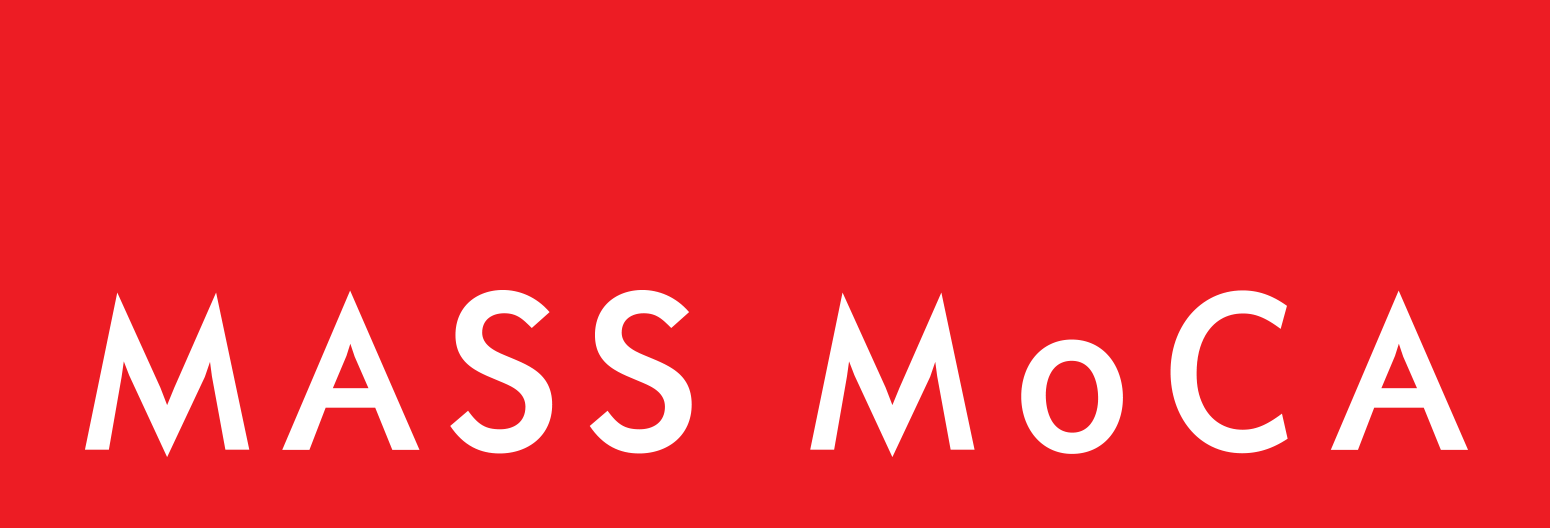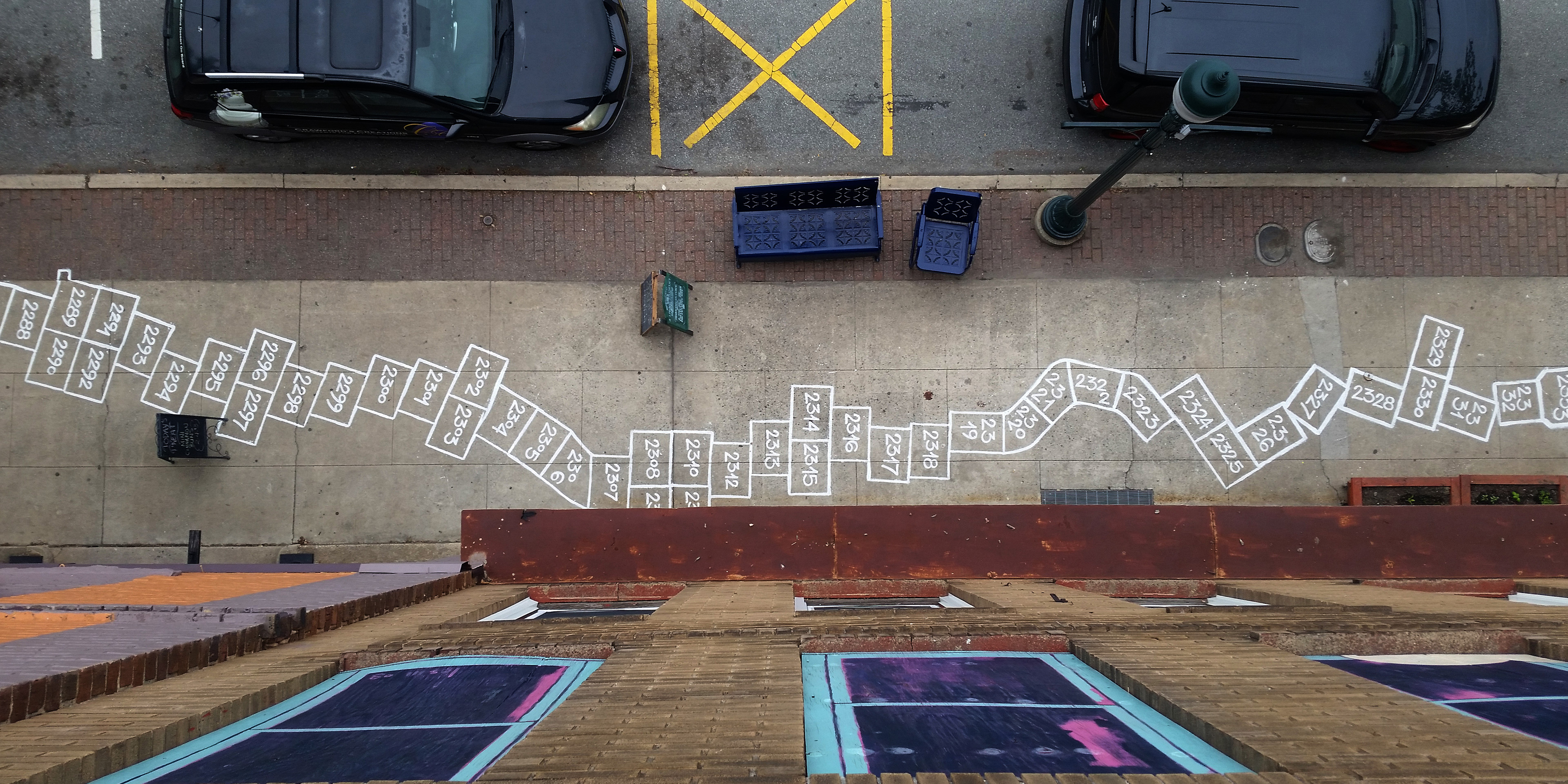For Immediate Release
28 January 2016
Contact: Jodi Joseph
Director of Communications
413.664.4481 x8113
jjoseph@massmoca.org
The Space Between
Installations highlight spaces around, below, and beyond the galleries
NORTH ADAMS, MASSACHUSETTS — Industrial stairwells, covered bridges, sunlit niches, and brick-lined courtyards: the nooks and crannies around, below, and between MASS MoCA’s galleries sometimes go unnoticed. These are the areas that lie between one destination and the next, and are found by chance as visitors wander the museum. Patrons typically do not stop or linger in these places, but rather pass through on the way to the next exhibition. The Space Between, on view beginning April 16, inhabits these spaces of “just passing through.” The exhibition culminates with a May installation of an impossibly long hopscotch court stretching between the museum and Main Street in downtown North Adams, Mass.
The Space Between, organized by Nina Wexelblatt, a student in the Williams College Graduate Program in the History of Art, features the work of artists Zarouhie Abdalian, Walead Beshty, Edson Chagas, Andy Graydon, Amalia Pica, Rachel Sussman, and Audra Wolowiec. Each of the installations, which vary in form — from sculpture and photography to sound and architectural intervention — investigates a different element of the in-between as both a physical location and an abstract condition. The works in this show variously address the space between idea and execution; between speaker and listener; and between cities, neighborhoods, and words. Some works occupy the cracks in the physical infrastructure, while others expose the systems that make the factory-turned-museum into a locus of cultural activity. Each reminds us that a museum is not a static site for the presentation of finished products, but is constantly changing.
The placement of the works purposefully reorients the visitors’ awareness of areas outside the galleries, facilitating encounters with art often where one may least expect it: from the parking lot to work sheds, from the museum lobby to covered corridors between buildings, and out into the city streets of downtown North Adams. Individually, these interventions both index and transform their locations. Together they create a network that maps a new set of relations within transitional spaces.
These works, both playful and contemplative, seek to occupy and invigorate the existing interstitial areas, as well as to create new connections. It is possible to stumble upon them by chance or, armed with a brochure doubling as a map, visitors may travel through the museum and beyond to deliberately explore what they might otherwise ignore.
Greeting visitors in the lobby, a swirl of confetti on the floor suggests that a party has just ended. Amalia Pica’s Stabile #2 (with confetti) (2012) suspends what was once a flutter of motion into a quiet monument to both celebration and labor. The ephemeral act of merriment between friends is frozen in the random pattern left behind by the spontaneous bursts of confetti, each colorful circle painstakingly affixed to the floor with Scotch Tape.
Spread throughout the expanse of a soaring atrium connecting two buildings and the three floors of the Sol LeWitt exhibition is a site-specific commission by Andy Graydon. The sound work features a number of voices, each emanating from a different stairwell landing, mumbling as thoughts are formed. Visitors encounter multiple incomplete proposals for artworks to fill the atrium, which ultimately leads to a heightened awareness of precisely what is already in the space.
Another sound work is by Zarouhie Abdalian and also focuses on the fraught gap between idea and execution. A voice reverberates out from the brick walls of a garage and an outbuilding and marks the borders of a small open space by listing a compendium of words related to labor. Situated near a construction project under way in a nearby part of the campus, the words ricochet along the road taken by trucks carrying equipment, inviting visitors to take the same journey.
Systems that underpin the museum operations are made manifest in sculpture by Walead Beshty. A glass cube sits atop a cardboard FedEx box as though it was just unpacked. Indeed, the fragile object has been shipped via FedEx to the museum, and invariably shows traces of its handling.
Fracture is investigated by Rachel Sussman, who restores cracks in pavement in the museum parking lot by adapting the Japanese art of kintsukuroi. On the ground in the interior courtyard behind the museum’s main building, resin and gold powder fill the cracks on the ground caused by cars and weather. The tiny streams of gold create fractal patterns recalling aerial topographical photographs. The philosophy of kintsukuroi treats cracks as fundamental parts of an object, noting that value lies in accepting change and underscoring the aesthetic qualities of imperfection and use rather than disguising flaws.
Audra Wolowiec investigates gaps in the space of language itself. Her work private space in a public time (2010) references artist Vito Acconci’s 1990 essay “Public Space in a Private Time,” which characterizes public space today as “circulation routes; not buildings and plazas but roads and bridges.” Situated within a passageway between two museum buildings, Wolowiec’s installation alters Acconci’s text by “erasing” the vowels, whiting them out by hand. Referencing musical notation, Wolowiec has drawn in slurs (curved lines that are normally used to connect two notes) between each word, deconstructing the essay and remaking it as a series of bridges from word to word, recalling the bridge in which it is installed. This poetic manipulation of the written word is treated as a score and performed like a musical composition. The sound of breath between words, punctuated by bursts of consonants, follows visitors as they pass from one building to the next. Wolowiec lets us listen in on a fundamental and active part of spoken language that might otherwise be dismissed as silence.
Outside the museum near the corner of Marshall and River Streets, two photographs by Edson Chagas, one taken in London and one taken in his hometown of Luanda, Angola, will be installed on two billboards. His series Found Not Taken features images of objects the artist has discovered in the streets of both cities. Set against minimal backgrounds, the objects are divorced from any visible cultural context. This generalized formal quality reflects the mobile nature of the objects themselves, discarded remnants of consumerism within a rapidly expanding global economy. Yet they remain significantly embedded in the site in which they were found: the objects and the resulting images are evidence of a specific encounter in a specific place. The large photographs are installed side by side on either half of the billboard, separated by a narrow space. This gap functions as a site of productive tension, implicitly reminding us of the social and political distance between the two very different cities.
Sponsorship
This exhibition is made possible by the Sterling and Francine Clark Art Institute in support of MASS MoCA and the Williams College Graduate Program in the History of Art. The exhibition is curated by Nina Wexelblatt, a second-year student in the Williams College Graduate Program.
Images
A collection of high-resolution images is available here: bit.ly/1ZI3i77.
About the Artists
Zarouhie Abdalian (New Orleans, LA) investigates memory and boundaries in perception and the built environment. Recent exhibitions have taken place at the Berkeley Art Museum, CA; Prospect.3, New Orleans, LA; 2012 Shanghai Biennial; 12th Istanbul Biennial; and 8th Berlin Biennale. Abdalian lives in Oakland, CA, and is represented by Altman Siegel Gallery, San Francisco.
Walead Beshty (London, England) examines process and exposes the effects of political and social systems. Solo exhibitions include the Barbican Centre, London; the Hirshhorn Museum and Sculpture Garden, Washington, D.C.; the Hammer Museum, Los Angeles, CA; and MoMA PS1 Contemporary Art Center, New York, NY. His work has been included in the 56th La Biennale Venezia, 2012 Shanghai Biennial, and 2008 Whitney Biennial. Beshty lives in Los Angeles, CA, and is represented by Petzel Gallery, New York.
Edson Chagas (Luanda, Angola) uses photography to explore location, identity, and difference. Solo exhibitions have taken place at Instituto Camões, Centro Cultural Português, Luanda; Belfast Exposed Photography, Belfast; and Memorial Agostinho Neto, Luanda. His Found Not Taken series won the Golden Lion at the 55th Venice Biennale. Chagas lives in Luanda and is represented by Stevenson Gallery, Johannesburg.
Andy Graydon (Maui, HI) works within sites to generate situations of absence and displacement. Recent exhibitions include The New Museum, New York, NY; The Berlinische Galerie, Berlin; Frye Art Museum, Seattle, WA; the Utah Museum of Contemporary Art, Salt Lake City; The Honolulu Museum of Art, Hawaii; and The Hong Kong & Shenzhen Biennale of Urbanism\Architecture. Graydon lives in Boston, MA.
Amalia Pica (Neuquén, Argentina) wryly explores gaps and junctures between communication, politics, and abstraction. Recent solo exhibitions have taken place at Van Abbemuseum, Eindhoven, Netherlands; La Criée Centre d’Art Contemporain, Rennes, France; Museum of Contemporary Art, Chicago; MIT List Visual Arts Center, Cambridge, MA; and Kunsthalle Lissabon, Lisbon, Portugal. Pica lives in London, UK, and is represented by Marc Foxx Gallery, Los Angeles.
Rachel Sussman (Baltimore, MD) has a keen interest in the patterns and processes of the natural world. Solo exhibitions have taken place at Pioneer Works, New York, NY; Staatliche Kunsthalle Baden-Baden; Berlin Botanical Museum; and School of Visual Arts Gallery, New York, NY. She was the 2014 recipient of the Art + Technology Lab Grant from the Los Angeles County Museum of Art and a 2014 Guggenheim Fellow. Sussman lives in Brooklyn, NY.
Audra Wolowiec (Detroit, MI) gives tangible presence to ephemeral phenomena such as sound and language. Recent exhibitions and performances include Jordan Schnitzer Museum of Art, Eugene, OR; Socrates Sculpture Park, New York, NY; MoMA PS1 Contemporary Art Center, New York, NY; and the Knockdown Center, Queens, NY. She was the 2015 Artist Educator at Dia:Beacon, NY. Wolowiec lives in New York City.
About MASS MoCA
MASS MoCA is one of the world’s liveliest (and largest) centers for making and enjoying today’s most important art, music, dance, theater, film, and video. Hundreds of works of visual and performing art have been created on its 19th-century factory campus during fabrication and rehearsal residencies, making MASS MoCA among the most productive sites in the country for the creation and presentation of new art. More platform than box, MASS MoCA strives to bring to its audiences art experiences that are fresh, engaging, and transformative.
MASS MoCA’s galleries are open 11am to 5pm every day except Tuesdays. The Hall Art Foundation’s Anselm Kiefer exhibition is seasonal and reopens April 30, 2016. Gallery admission is $18 for adults, $16 for veterans and seniors, $12 for students, $8 for children 6 to 16, and free for children 5 and under. Members are admitted free year-round. For additional information, call 413.662.2111 x1 or visit massmoca.org.

